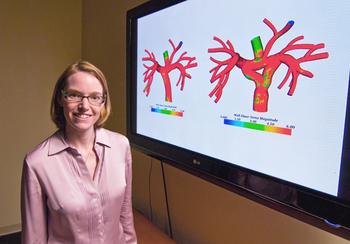 UCSD structural engineering professor Benson
UCSD structural engineering professor Benson
Shing is developing innovative methodologies and improved
design requirements for shear walls in reinforced masonry buildings
to enhance the resistence of these structures during
earthquakes. To see a related video, please click
here.
San Diego, CA, July 16, 2010— In
between spring and fall quarters, engineering professors at
UC San Diego are working to keep society safe, healthy and on
the leading edge of smart technologies through a variety of
research projects – from keeping buildings earthquake safe to
enhancing heart surgery for children and developing the next
generation of nano sensors. Below is a sample of what’s
happening this summer inside and out of UCSD’S Jacobs School of
Engineering labs.
Earthquake-Safe Buildings
As earthquake preparedness continues to be at the forefront of
research and conversations around the globe, engineers at UC San
Diego have received a boost in funding to help protect buildings
and people from potential seismic disasters.
Benson Shing, a structural engineering professor at the UC San
Diego Jacobs School of Engineering, will use a nearly $1.5 million
grant from the U.S. Commerce Department’s National Institute of
Standards and Technology (NIST) to study and test
performance-based seismic design methods and tools for reinforced
masonry shear-wall structures. Under the three-year project, Shing
and his colleagues will develop innovative methodologies and
improved design requirements for the seismic resistance design of
shear walls in reinforced masonry buildings, and reliable
analytical tools for assessing their seismic performance in
an effort to enhance the cost-effectiveness and performance of
these structures. These types of masonry structures are
mainly used for low rise commercial buildings, as well as for
mid-to-low rise office buildings and hotels. As part of the grant,
Shing plans to conduct a series of simulated earthquake tests on
two-and-three-story shear wall systems at the end of 2011 and in
early 2012 at the UC San Diego Englekirk Structural Engineering
Center, home of the world’s largest outdoor shake table.
“We hope to break new ground in design and
modeling,” Shing said about the project.
Earlier this year, the NSIT awarded a total of $34.12 million in
grants for measurement science and engineering research. The NIST
Measurement Science and Engineering Research Grants Program, made
possible through the American Recovery and Reinvestment Act, will
fund 27 projects at higher-education, commercial, and nonprofit
organizations in 18 states.
Enhancing Heart Surgery For Children
UC San Diego mechanical and aerospace engineering professor
Alison Marsden is working through an international collaboration to
develop multiscale models for all three stages of the surgery used
to treat children with single ventricle heart defects. The end goal
of the $6 million project, funded by Fondation Leducq in France, is
to produce software that can be used for clinical decision support.
These surgeries are typically done with three stages starting from
birth: the Norwood (or variant), Glenn procedure, and Fontan
surgery. According to Marsden, these young patients are among the
most challenging for pediatric cardiologists to treat, and they can
develop a number of very serious morbidities.
 |
| Alison Marsden, a UCSD mechanical and aerospace engineering professor, is developing tools to help pediatric heart surgeons. |
“While our group at UCSD has done research previously on
the Fontan surgery (stage three), we were not able to take
advantage of closed loop models of the circulatory system,”
she said. “This collaboration will allow us to model the
surgical connection in detail as well as the response of the entire
circulation. In addition, this is the first time in our research
group that we are taking a close look at the engineering aspects of
the first two stages of the surgery, and that will hopefully shed
light on possibilities for earlier interventions that can help
prevent poor outcomes. The network gives us access to a large pool
of clinical data through several leading clinical centers that are
participating in the grant.”
Marsden is an American core member of the international research
team on this project, which also includes Great Ormond Street
Hospital for Children in London, Politecnico di Milano in Milan,
The French National Institute for Research in Computer Science and
Control (INRIA) in Paris, Medical University of South Carolina,
University of Michigan, and Clemson University.
NextGen Nano Sensors
| UCSD nanoengineering professor Jen Cha is developing nanoscale materials for biological and chemical sensing for health and environmental monitoring for the U.S. Deparment of Defense. |
UC San Diego nanoengineering professor Jen Cha is using a $300,000
grant from the U.S Defense Department’s Advanced Research Projects
Agency (DARPA) to develop nanoscale materials for biological and
chemical sensing for health and environmental monitoring. Cha
and her research team are hoping to find routes to fabricate arrays
of nanoscale materials for medical diagnostics or for security
sensing that does not require high engineering costs. For these
types of applications to make a “real world” impact,
the production of the devices needs to be kept at an absolute
minimum, Cha explained.
“If we can get around the problem of repeatedly needing an
expensive tool, such as those used for semiconductor chip
manufacturing (i.e. lithography), and still be able to achieve
sub-50 nanometer resolution, that would be pretty revolutionary for
applications such as low-cost diagnostics and chemical
sensors,” she said.

